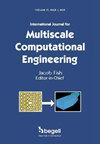PREFACE: REVOLUTIONIZING ENGINEERING PRACTICE BYMULTISCALE METHODS
IF 1.4
4区 工程技术
Q2 ENGINEERING, MULTIDISCIPLINARY
International Journal for Multiscale Computational Engineering
Pub Date : 2021-01-01
DOI:10.1615/intjmultcompeng.v19.i4.10
引用次数: 0
Abstract
Accelerated adoption of multiscale technologies, or any technology for that matter, depends not only on the successes of individual organizations that promote them but rather on their broader acceptance as a technology of choice. Precisely for this reason, on January 4, 2021, a number of leading commercial software vendors were invited to showcase the progress they made in developing transformational multiscale technologies and to report the impact their multiscale technologies have made on Integrated Computational Materials Engineering (ICME). Several software vendors including Dassault Systemes SIMULIA, HEXAGON MSC, Altair, Siemens, and NASA Glenn accepted this challenge. The special issue entitled “Revolutionizing Engineering Practice by Multiscale Methods,” organized by the International Journal for Multiscale Computational Engineering, provides the platform for these contributions. Since the special issue contributors were not requested to follow any specific manuscript outline or its length, various manuscripts have different flavor, scope, and focus. In the following, I provide a self-imposed six-line summary of various contributions in coordination with individual article writers. Dassault Systemes SIMULIA’s article (Bi et al., 2021) focuses on both the breadth and depth of their multiscale capabilities. SIMULIAmultiscale capabilities comprise a broad range of scales ranging from the quantum scale all the way to the product scale and for multiple, often coupled, physical processes that include solids, fluids, electromagnetics, thermal, and controls. These capabilities are housed in three Dassault Systemes products, CATIA for product design, SIMULIA for simulation for design, and BIOVIA for computational chemistry and materials science, all of which are integrated in a single business environment, the 3DEXPERIENCE Platform. The article of MSC Software (part of Hexagon Manufacturing Intelligence) (Doghri et al., 2021), and its center of excellence focusing on materials (formerly e-Xstream engineering), overviews the Digimat software platform including its theoretical background and applications in materials engineering, virtual testing, process engineering, and structural engineering, for various materials and manufacturing processes including additive manufacturing. The primary objective is to present the key concepts behind multiscale-grounded ICME and illustrate that it achieved a level of maturity which enabled it to make the transition from academic research to predictive engineering design. Altair’s article (Wollschlager et al., 2021) focuses on the technical overview of Multiscale Designer, which houses its multiscale capabilities. Multiscale Designer is employed for the development of multiscale material models for various heterogeneous anisotropic material including, but not limited to, continuous and chopped fibrous composites, honeycomb cores, lattice structures, reinforced concrete, soil, etc. Multiscale Designer offers user material plug-ins to commercial finite element solvers; Altair’s OptiStruct & Radioss, Abaqus, Ansys, and LS-Dyna. Applications include structural design, ultimate load assessment, material allowables, creep, fracture, and impact. Siemens’ article (Song et al., 2021) focuses on the applications of the Simcenter Multimech multiscale material modeling and simulation platform based on the FE 2 multiscale approach. The first application focuses on virtual testing of fiber reinforced composites for the purpose of expediting material development. The second application studies crack initiation and propagation due to thermal and mechanical effects of C/C-SiC material, where cracks in the matrix material or in the fiber/matrix interface can be modeled explicitly. The third application utilizes multiscale modeling in the research of advanced nanomaterials. NASA Glenn’s article (Pineda et al., 2021) focuses on an overview of the NASA Multiscale Analysis Tool (NASMAT) software platform for multiscale modeling of composites for engineering applications. NASMAT performs analysis of materials with any arbitrary number of length scales through the use of recursive procedures and data structures and also can function as an effective material model within structural finite element models. NASMAT is前言:用多尺度方法革新工程实践
加速采用多尺度技术,或就此而言的任何技术,不仅取决于推动它们的个别组织的成功,而且取决于它们作为一种可选择的技术得到更广泛的接受。正是出于这个原因,2021年1月4日,一些领先的商业软件供应商被邀请展示他们在开发转型多尺度技术方面取得的进展,并报告他们的多尺度技术对集成计算材料工程(ICME)的影响。包括达索系统SIMULIA、海克斯康MSC、Altair、西门子和NASA Glenn在内的几家软件供应商接受了这一挑战。由《国际多尺度计算工程杂志》组织的题为“用多尺度方法革新工程实践”的特刊为这些贡献提供了平台。由于特刊的撰稿人没有被要求遵循任何特定的手稿大纲或长度,所以不同的手稿有不同的风格、范围和重点。在下文中,我提供了一份与个别文章作者协调的各种贡献的自我强加的六行总结。达索系统SIMULIA的文章(Bi et al., 2021)侧重于其多尺度能力的广度和深度。simuli多尺度功能包括广泛的尺度,从量子尺度一直到产品尺度,以及包括固体、流体、电磁、热和控制在内的多个通常耦合的物理过程。这些功能包含在达索系统的三款产品中:CATIA用于产品设计,SIMULIA用于设计仿真,BIOVIA用于计算化学和材料科学,所有这些都集成在一个单一的业务环境中,即3DEXPERIENCE平台。MSC Software (Hexagon Manufacturing Intelligence的一部分)(Doghri et al., 2021)及其专注于材料(以前的e-Xstream工程)的卓越中心的文章概述了Digimat软件平台,包括其理论背景和在材料工程、虚拟测试、工艺工程和结构工程方面的应用,适用于各种材料和制造工艺,包括增材制造。主要目标是介绍多尺度基础ICME背后的关键概念,并说明它达到了一个成熟的水平,使其能够从学术研究过渡到预测工程设计。Altair的文章(Wollschlager et al., 2021)侧重于Multiscale Designer的技术概述,其中包含其多尺度功能。Multiscale Designer用于开发各种非均质各向异性材料的多尺度材料模型,包括但不限于连续和剪切纤维复合材料、蜂窝芯、晶格结构、钢筋混凝土、土壤等。Multiscale Designer为商业有限元求解器提供用户材料插件;Altair的OptiStruct & Radioss, Abaqus, Ansys和LS-Dyna。应用包括结构设计、极限载荷评估、材料允许量、蠕变、断裂和冲击。Siemens的文章(Song et al., 2021)重点介绍了基于fe2多尺度方法的Simcenter Multimech多尺度材料建模和仿真平台的应用。第一个应用侧重于纤维增强复合材料的虚拟测试,以加快材料的开发。第二个应用研究了C/C- sic材料的热和力学效应引起的裂纹萌生和扩展,其中基体材料或纤维/基体界面中的裂纹可以明确地建模。第三个应用是利用多尺度建模来研究先进的纳米材料。NASA Glenn的文章(Pineda et al., 2021)重点概述了用于工程应用的复合材料多尺度建模的NASA多尺度分析工具(NASMAT)软件平台。NASMAT通过使用递归程序和数据结构对任意数量长度尺度的材料进行分析,也可以作为结构有限元模型中的有效材料模型。NASMAT是
本文章由计算机程序翻译,如有差异,请以英文原文为准。
求助全文
约1分钟内获得全文
求助全文
来源期刊
CiteScore
3.40
自引率
14.30%
发文量
44
审稿时长
>12 weeks
期刊介绍:
The aim of the journal is to advance the research and practice in diverse areas of Multiscale Computational Science and Engineering. The journal will publish original papers and educational articles of general value to the field that will bridge the gap between modeling, simulation and design of products based on multiscale principles. The scope of the journal includes papers concerned with bridging of physical scales, ranging from the atomic level to full scale products and problems involving multiple physical processes interacting at multiple spatial and temporal scales. The emerging areas of computational nanotechnology and computational biotechnology and computational energy sciences are of particular interest to the journal. The journal is intended to be of interest and use to researchers and practitioners in academic, governmental and industrial communities.

 求助内容:
求助内容: 应助结果提醒方式:
应助结果提醒方式:


